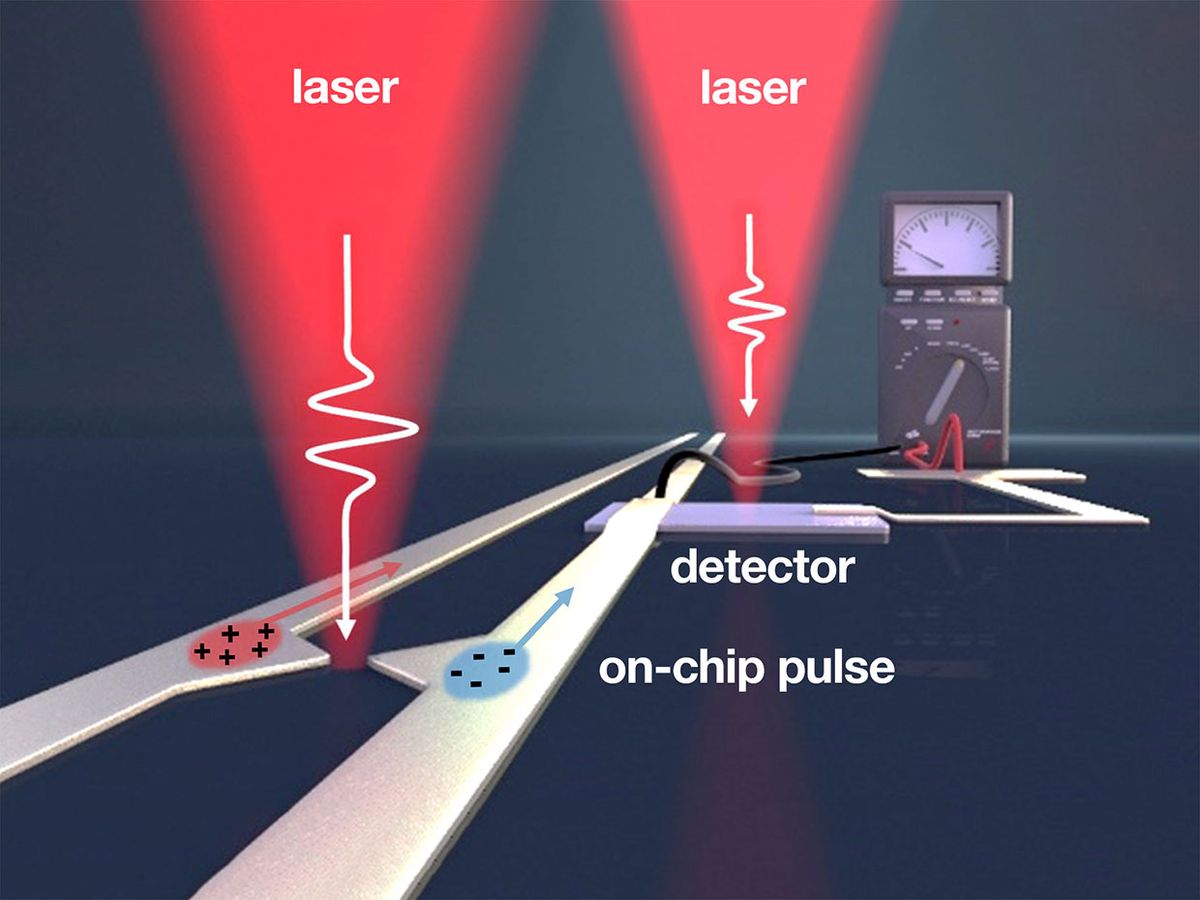Imagine an antenna that could transmit at terahertz frequencies—generally defined as those between 300 gigahertz (GHz) and 3 terahertz (THz). Such an antenna could send and receive data at rates that would be orders of magnitude faster than any device we currently use. Even the 5G networks now being deployed will operate, at best, on frequencies well below 100 GHz.
Now, a team at the Technical University of Munich, headed by Alexander Holleitner and Reinhard Kienberger, has developed a terahertz antenna—but it won’t ever be used to send signals over the air. The TUM team’s antenna is designed to use electrons to transfer data across a minuscule gap on the surface of a chip. Their technique could open the door for much faster on-chip signal generation.
The antenna uses a quantum property of electrons to transmit very-high-frequency signals across narrow gaps, and could generate signals for on-chip communication at rates far exceeding any technology currently available for moving bits of information across a chip.
The process begins with a phase-coherent laser, as the group describes in a recent Nature Communications report. “What is crucial is that it’s phase-stable,” Holleitner says. That is, each pulse has the exact same shape. Those laser pulses are used to excite delocalized electrons—those that are “free floating” rather than those attached to any atom in particular. These free-floating electrons, as the name suggests, are free to move between the atoms of the material they find themselves in—in this case, a tiny on-chip antenna.
When a photon from the laser pulse strikes one of these delocalized electrons, the electron produces a plasmon wave. These waves, associated with the frequency of a vibrating electron rather than with the wavelength of a traveling photon, have a much shorter wavelength than electromagnetic waves. Shorter wavelengths mean smaller components—the upshot being that plasmonic antennas can transfer a lot of data in a very small space.

The second key to this design is to use an asymmetric antenna, which means that the emitter and the receiver, only nanometers apart, have different shapes, with the emitter side featuring more of a curve than the receiver side. It’s important to note that the Munich team is not the first to develop a plasmonic antenna. But past attempts used symmetric antennas, which Holleitner says make it difficult to pick up the signal because, ultimately, they don’t generate a favorable current for the electrons to easily cross the gap. But Holleitner and the others discovered that by using asymmetric antennas (or, as they more accurately refer to them, “nanojunctions”), they could receive a stronger signal.
It’s important to stress how small this entire setup is. The distance between the two nanojunctions that a signal will cross is 10 micrometers, about the thickness of a single cotton fiber. The data will be carried by the vibrating electron that is shot across that minuscule gap. “It’s just physics—you need to have very small gaps,” Holleitner says. Otherwise the electron wouldn’t make it.
The electron-exciting laser sends out 20 femtosecond-long pulses, which means that in one second, 50 trillion electrons would make the microscopic trip between nanojunctions. If each one was carrying one bit of data, that works out to a clean 10-terahertz transmission.
Holleitner says the team’s creation could be built on a silicon chip, and imagines that someday it could be used for extremely fast signal generation for communications.
For now, Holleitner is focused on finding a way to control the laser’s phase. “We tried controlling the phase, but the laser wasn’t strong enough,” he says, and explains that controlling the phase would enable them to create even higher frequency plasmonic antennas. And those higher frequencies will mean even faster processors.
Michael Koziol is an associate editor at IEEE Spectrum where he covers everything telecommunications. He graduated from Seattle University with bachelor's degrees in English and physics, and earned his master's degree in science journalism from New York University.



